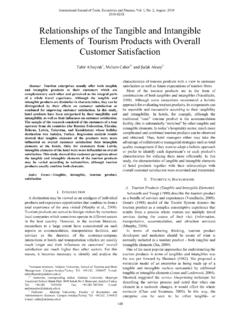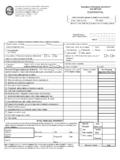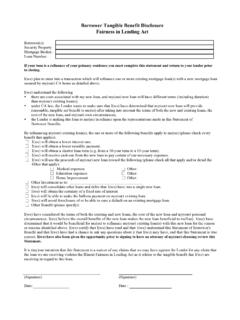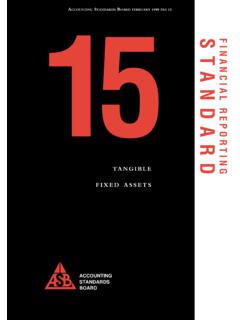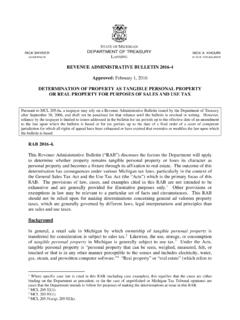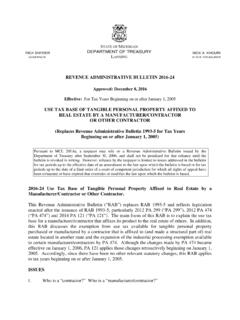Transcription of Capitalization of Tangible Property
1 Internal Revenue Service Capitalization of Tangible Property Treas. Reg. (a) and related regulations Large Business and International 9/14/2016 Table of Contents CHAPTER 1 EXAMINATION OF Tangible Property .. i INTRODUCTION .. 1 Capitalization OF Tangible Property BACKGROUND .. 1 FINAL REGULATIONS - OVERVIEW .. 3 GENERAL TERMINOLOGY .. 4 CHAPTER 2 COMPLIANCE CONSIDERATIONS .. 11 IMPLEMENTATION OF THE REGULATIONS .. 11 Capitalization TO REPAIR STUDIES .. 11 STAND DOWN .. 12 STATISTICAL SAMPLING .. 12 INDUSTRY SPECIFIC 13 COORDINATION WITH OTHER CODE SECTIONS .. 15 EXAMINATION CONSIDERATIONS .. 19 INTERVIEW QUESTIONS .. 22 CHAPTER 3 UNIT OF Property .. 24 INTRODUCTION .. 24 DETERMINING THE UOP .. 24 BUILDINGS .. 26 Property OTHER THAN BUILDINGS .. 29 COST SEGREGATION 31 IMPROVEMENTS TO 31 ADDITIONAL RULES .. 32 AUDIT PROCEDURES .. 33 i | Page CHAPTER 4 AMOUNTS PAID TO ACQUIRE OR PRODUCE Property .. 36 INTRODUCTION .. 36 GENERAL RULES.
2 36 EXCEPTIONS .. 37 DEFENSE OR PERFECTION OF TITLE .. 37 TRANSACTION COSTS .. 37 SPECIAL RULES .. 39 AUDIT PROCEDURES .. 40 CHAPTER 5 DE MINIMIS SAFE HARBOR .. 42 INTRODUCTION .. 42 SAFE HARBOR ELECTION .. 42 SAFE HARBOR REQUIREMENTS AND LIMITATIONS .. 43 APPLICABLE FINANCIAL STATEMENTS .. 45 ACCOUNTING POLICY .. 45 ADDITIONAL RULES .. 47 EXCEPTIONS TO THE SAFE HARBOR .. 48 ANTI-ABUSE RULE .. 48 AUDIT PROCEDURES .. 49 CHAPTER 6 IMPROVEMENT RULES BETTERMENTS .. 52 IMPROVEMENTS IN GENERAL .. 52 BETTERMENTS .. 52 APPLICATION OF THE BETTERMENT RULES .. 54 AUDIT PROCEDURES .. 57 ii | Page CHAPTER 7 IMPROVEMENT RULES RESTORATIONS .. 60 IMPROVEMENTS IN GENERAL .. 60 RESTORATIONS .. 60 REPLACEMENT OF A COMPONENT OF A UOP LOSS DEDUCTED (NOT A CASUALTY LOSS).. 61 REPLACEMENT OF A COMPONENT OF A UOP GAIN/LOSS REALIZED AND BASIS ADJUSTED .. 62 REPLACMENT OF A MAJOR COMPONENT/SUBSTANTIAL STRUCTURAL PART OF A UOP .. 63 RESTORATION OF DAMAGE FROM A CASUALTY LOSS.
3 67 RETURNS THE UOP TO OPERATIONAL CONDITION AFTER DETERIORATED AND NON-FUNCTIONAL .. 68 REBUILDS TO LIKE-NEW CONDITION AFTER THE END OF CLASS LIFE .. 69 AUDIT PROCEDURES .. 70 CHAPTER 8 IMPROVEMENT RULES NEW OR DIFFERENT USE .. 74 IMPROVEMENTS IN GENERAL .. 74 NEW OR DIFFERENT USE .. 74 AUDIT PROCEDURES .. 76 CHAPTER 9 SAFE HARBORS SPECIAL RULES OTHER PROVISIONS .. 78 INTRODUCTION .. 78 SAFE HARBOR FOR ROUTINE MAINTENANCE .. 78 SAFE HARBOR FOR SMALL TAXPAYERS .. 82 CERTAIN COSTS INCURRED DURING AN IMPROVEMENT .. 84 SPECIAL RULES FOR REMOVAL COSTS .. 85 OPTIONAL REGULATORY ACCOUNTING METHOD .. 87 iii | Page ELECTION TO CAPITALIZE REPAIR AND MAINTENANCE COSTS .. 88 ELECTION TO DEDUCT OR CAPITALIZE EXPENDITURES UNDER OTHER IRC SECTIONS .. 89 CHAPTER 10 MATERIALS AND SUPPLIES .. 90 INTRODUCTION .. 90 AMOUNTS PAID TO ACQUIRE OR PRODUCE A UNIT OF Property EXCEPTION FOR MATERIALS AND SUPPLIES .. 90 TIMING OF DEDUCTION FOR MATERIALS AND SUPPLIES.
4 90 DEFINITION OF MATERIALS AND SUPPLIES .. 91 COORDINATION OF 263(a) and 263A .. 92 ROTABLE, TEMPORARY, AND STANDBY EMERGENCY SPARE PARTS .. 93 ELECTION TO CAPITALIZE AND DEPRECIATE ROTABLE, TEMPORARY, AND EMERGENCY SPARE PARTS .. 94 OPTIONAL METHOD OF ACCOUNTING FOR ROTABLE AND TEMPORARY SPARE PARTS .. 95 DE MINIMIS SAFE HARBOR ELECTION .. 96 ACCOUNTING METHOD CHANGES AND EFFECTIVE DATES .. 96 MATERIALS AND SUPPLIES SUMMARY .. 98 AUDIT PROCEDURES .. 99 CHAPTER 11 LEASED Property .. 102 INTRODUCTION .. 102 LEASEHOLD IMPROVEMENTS UNDER THE FINAL REGULATIONS .. 102 COORDINATION WITH SECTION 263A .. 103 LEASEHOLD IMPROVEMENT OR ACQUISITION OF Tangible Property ? .. 103 LEASED BUILDING 103 LEASED PROPERY OTHER THAN BUILDINGS .. 105 COST RECOVERY FOR LEASEHOLD IMPROVEMENTS .. 106 iv | Page AUDIT PROCEDURES .. 107 CHAPTER 12 DISPOSITION CONCEPTS AND MACRS ACCOUNTING RULES .. 109 INTRODUCTION .. 109 DISPOSITION CONCEPTS .. 109 ACCOUNTING FOR MACRS Property .
5 114 SPECIAL RULES FOR MULTIPLE ASSET ACCOUNTS .. 118 ACCOUNTING FOR DISPOSITIONS .. 119 ACCOUNTING METHOD .. 120 AUDIT PROCEDURES .. 121 CHAPTER 13 DISPOSITIONS IN GENERAL .. 123 INTRODUCTION .. 123 DEFINITION OF A 123 DETERMINATION OF THE DISPOSED ASSET .. 125 AUDIT PROCEDURES .. 127 CHAPTER 14 MACRS DISPOSITION RULES .. 131 INTRODUCTION .. 131 DISPOSITIONS OF MACRS Property IN GENERAL .. 131 DISPOSITION OF A PORTION OF AN ASSET FROM AN SAA OR MAA .. 133 GAIN OR LOSS ON DISPOSITIONS OF MACRS Property .. 137 STATISTICAL SAMPLING .. 140 AUDIT PROCEDURES .. 140 CHAPTER 15 GENERAL ASSET ACCOUNT RULES .. 145 INTRODUCTION .. 145 ELECTION OF A GAA .. 145 v | Page ESTABLISHING A GAA .. 145 DISPOSITIONS FROM A GAA IN GENERAL .. 147 GAIN OR LOSS ON DISPOSITIONS FROM A GAA .. 147 GAA TERMINATIONS .. 148 AUDIT PROCEDURES .. 152 CHAPTER 16 ACCOUNTING METHOD CHANGES .. 155 METHODS OF ACCOUNTING IN GENERAL .. 155 BACKGROUND .. 156 IDENTIFYING POTENTIAL AUDIT ISSUES.
6 161 AUDIT PROCEDURES .. 165 CHAPTER 17 ACCOUNTING METHOD CHANGES - Capitalization .. 171 APPLICABLE METHOD CHANGE PROCEDURES .. 171 SPECIFIC METHOD CHANGES TO COMPLY WITH THE FINAL Capitalization REGULATIONS .. 175 CHANGES INCLUDED IN REV. PROC. 2015-14 AND REV. PROC. 2016-29 .. 179 CHAPTER 18 ACCOUNTING METHOD CHANGES - DEPRECIATION AND DISPOSITIONS .. 180 APPLICABLE METHOD CHANGE PROCEDURES .. 180 SPECIFIC METHOD CHANGES TO COMPLY WITH THE FINAL DEPRECIATION AND DISPOSITION REGULATIONS .. 185 CHANGES IN REV. PROC. 2015-14, AND REV. PROC. 2016-29 .. 189 CHANGES INCLUDED IN REV. PROC. 2015-14, and REV. PROC. 2016-29, .. 192 vi | Page CHAPTER 1 EXAMINATION OF Tangible Property INTRODUCTION This Audit Techniques Guide is for IRS examiners to use as a tool for identifying potential tax issues. Examiners are advised to carefully risk assess and apply the law to the facts and circumstances for issues involving Capitalization and dispositions of Tangible Property .
7 The IRS and Treasury began a project in 2004, to revise the Tangible Property regulations. In anticipation of these regulations, many taxpayers changed their method of accounting beginning as early as January 1, 2006. As a result, many of these taxpayers may now be using a method of accounting for tax purposes that is inconsistent with the final regulations. On March 15, 2012, examiners were instructed in an LB&I directive to discontinue examin-ing issues involving whether costs incurred to maintain, replace, or improve Tangible prop-erty must be capitalized under 263(a) and any correlative issues involving the disposition of structural components of a building or dispositions of Tangible depreciable The final regulations were issued in 2013. Taxpayers are now required to correct any prior method changes to comply with these regulations for tax years beginning on or after Janu-ary 1, 2014. The burden of proof rests with the taxpayer, and sufficient contemporaneous records are required.
8 Capitalization OF Tangible Property BACKGROUND Section 263(a) denies a deduction for any amounts paid out for new buildings or for per-manent improvements or betterments made to increase the value of any Property or estate, or any amount expended in restoring Property or in making good the exhaustion thereof for which an allowance is or has been made. Regulations previously issued under 263(a) provided that capital expenditures included amounts paid to add to the value, or substan-tia lly prolong the useful life, of Property owned by the taxpayer, or adapt the Property to a new or different use. The regulations also provided that amounts paid for certain incidental repairs of Property were not required to be capitalized. While 263(a) generally requires taxpayers to capitalize an amount paid to acquire, produce, or improve real or personal Tangible Property , 263A generally prescribes that direct and allocable indirect costs must be capitalized to Property produced by the taxpayer and Property acquired for resale.
9 Sec-tion 162 allows a current deduction for amounts paid or incurred for incidental repairs and maintenance and does not require Capitalization of these amounts. The United States Supreme Court has recognized the highly factual nature of determining whether expenditures are for capital improvements or for ordinary repairs. See Welch v. Helvering, 290 111, 114 (1933) ( [T]he decisive distinctions [between capital and ordi-1 LB&I 04-0312-004 1 | Page nary expenditures] are those of degree and not of kind ); Deputy v. du Pont, 308 488, 496 (1940) (observing that each case turns on its special facts ). Because of the factual nature of the issue, the courts have articulated a number of ways to distinguish between deductible repairs and non-deductible capital improvements. For example: Illinois Merchants Trust Co. v. Commissioner, 4 103, 106 (1926), the court ex-plained that repair and maintenance expenses are incurred for the purpose of keeping Property in an ordinarily efficient operating condition over its probable useful life for the uses for which the Property was acquired.
10 Capital expenditures, in contrast, are for re-placements, alterations, improvements, or additions that appreciably prolong the life of the Property , materially increase its value, or make it adaptable to a different use. Estate of Walling v. Commissioner, 373 190, 192-193 (3rd Cir. 1967), the court explained that the relevant distinction between capital improvements and repairs is whether the expenditures are to put or keep Property in efficient operating condi-tion. Plainfield-Union Water Co. v. Commissioner, 39 333, 338 (1962), the court stated that if the expenditure merely restores the Property to the state it was in before the sit-uation prompting the expenditure arose and does not make the Property more valua-ble, more useful, or longer-lived, then such an expenditure is usually considered a de-ductible repair. In contrast, a capital expenditure is generally considered to be a more permanent increment in the longevity, utility, or worth of the Property .










